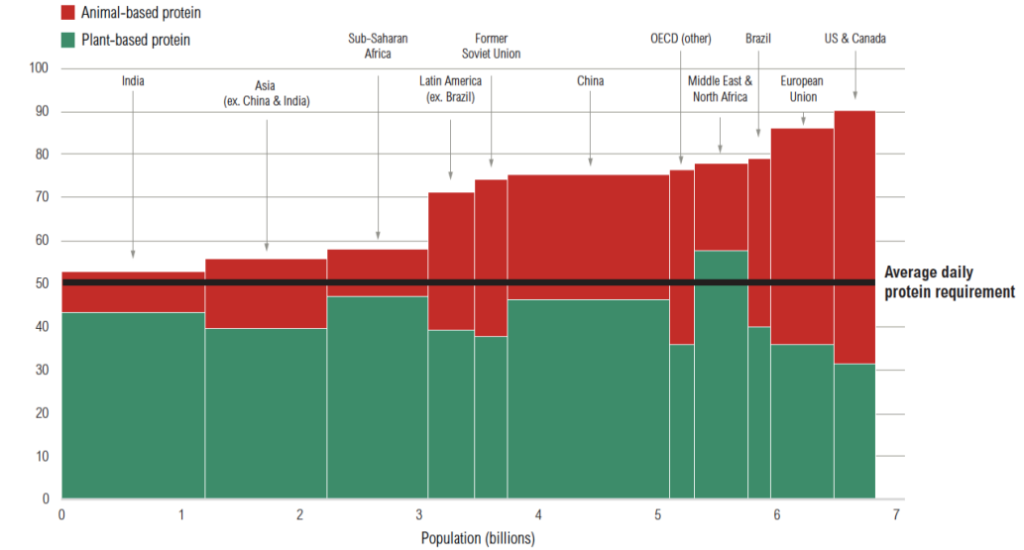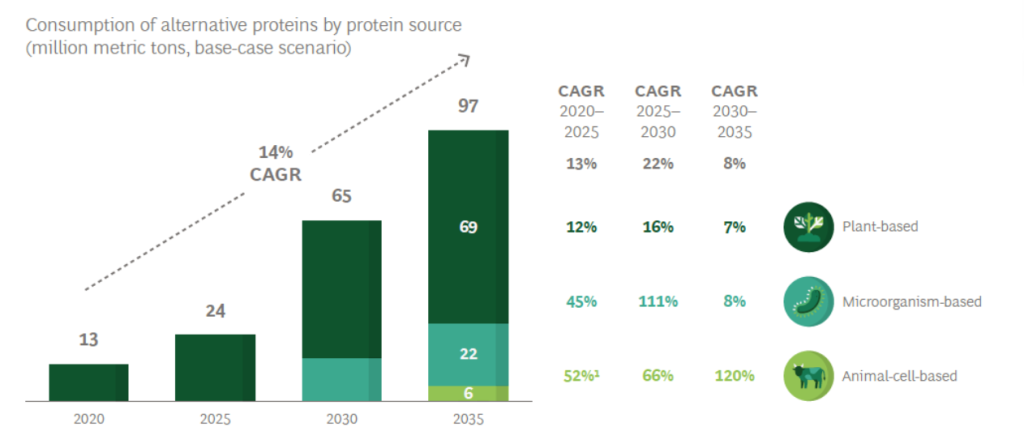Introduction
Protein is crucial for our diets, but conventional sources have a significant environmental impact, and their availability threatens Europe’s food security. The need for sustainable and accessible protein sources, together with a desire for healthier food choices, is driving the rapid growth of alternative proteins. However, challenges remain to achieve this shift, and, while plant-based proteins offer great potential, further research is needed to fully understand their long-term impact.
This summary article, based on the findings of the European Parliamentary Research Service (EPRS) and other relevant authorities, presents the future of alternative protein sources, their benefits, challenges and what is to expect from policymakers in the future.
The Protein Balance
From building strong bodies to repairing injuries, protein plays a vital role in the growth, repair, and maintenance of tissues in all animals, including humans [3]. Most protein consumption globally comes from traditional protein sources. Furthermore, the EPRS reports this evidence [3]:
- Globally most protein intake comes from plants (57%)
- In Europe, most protein intake comes from animal sources (60%)
- Globally, average daily protein intake exceeds the Recommended Daily Intake (RDI) by 33% (Figure 1)
- However, a significant portion of the global population remains food insecure. In 2018 alone, an estimated 662 million people were reported to be protein-deficient

European Protein “Deficit”
The EU relies heavily on imported protein, especially fish and animal feed. This has become a critical concern, especially after the Ukraine war’s impact on global supply chains [3]. Europe’s protein dependency threatens food security, and conventional protein sources have a strong environmental impact, particularly animal-based sources, which is a major concern [3].
Therefore, the current global and EU protein balance is facing scrutiny due to both geopolitical and environmental concerns [3]. According to the EPRS, a different approach is needed, with a shift not only in plant-to-animal protein ratio but also towards alternative protein sources [3].
Exploring Alternative Proteins
Though not protein deficient, the EU seeks alternatives to conventional animal sources for health, sustainability, and food security [3]. Three main categories are gaining traction: plant-based alternatives (most common), established alternatives from other cultures (e.g., insects) and novel alternatives [3]. Examples presented by the EPRS include:
- Algae – including seaweed and microalgae are kept at a small scale in Europe, however, their cultivation is gaining traction, with “spirulina” being among the most popular varieties
- Microbial fermentation – encompasses traditional, biomass and precision fermentation. Quorn exemplifies the success of biomass-fermented fungal protein while precision fermentation promises to take this approach further, optimizing yield, quality, and nutrition
- Insects – while traditionally consumed in other parts of the world, Western countries are now also exploring their potential as sustainable protein sources, also encouraged by organizations like the FAO
- Cultured meat – a novel alternative protein produced from animal cells in vitro, has no historical precedent as a food source and remains unauthorized in the EU
The Future of Protein Consumption: Projections to 2050
Establishing the future protein balance considering both conventional and alternative proteins is crucial for the future. Historically, global meat production and consumption have steadily risen, leading to projections of further significant growth by 2050 [3]. However, these projections often overlook the threat of climate change. The EPRS reports that climate change could lead to the following consequences for protein sources by 2050 [3]:
- Animal-based options: Climate change threatens livestock production, lowering output and potentially driving up costs, driving consumers towards alternative proteins
- For plant-based protein, projections rely on a reduction of meat diets, but climate change threatens their viability by impacting yield and protein content
- Alternative proteins (including plant-based) could gain 11-22% of the global protein market by 2035. In Europe, this could mean replacing up to 34% of conventional animal protein [3]. It is predicted that alternative proteins (including plant-based) could gain 11-22% of the global protein market by 2035 [5]

Drivers for Growth of Alternative Proteins
Projections for alternative protein also rely on consumer acceptance, regulatory support and technological advancements. According to estimations reported by the World Economic Forum [5]:
- Supportive regulations -> +22% alternative protein growth
- Technological steps changes -> +16% alternative protein growth
- Resistant consumers -> -10% alternative protein growth
Pros and Cons of Alternative Proteins
Like any major shift, embracing alternative proteins offers both benefits and challenges. Beyond the known environmental and protein availability advantages, potential pros and cons.
Alternative Proteins – Pros
- Environmental Benefits – Smaller carbon footprint and less resources required []
- Ethical Considerations – Reduced need for intensive farming, improving animal welfare [EIT]
- Health Aspects – Nutritional benefits and availability can reduce the risk of food insecurity [EIT]
Alternative Proteins – Cons
- Costs – Alternative proteins may have higher production costs, especially in the beginning [3,5]
- Acceptance – Consumers may hesitate to try alternative proteins due to differences in taste and texture [5]
- Regulatory Uncertainty – Regulations framework can impact market growth [2,3]
- Food Safety Risks – Potential food safety risks could be introduced by foods with no history of consumption [4]
Shaping the Future of Alternative Proteins: Regulatory Focus
Despite the need for protein diversification, legislation could be a roadblock. For instance, in the EU regulatory hurdles exist for novel alternative proteins: algae, precision-fermented and insect products fall under strict regulations. Cultured meat, instead, remains unauthorized [3]. A 2023 EIT policy brief [2] on protein diversification proposed conditions for a successful EU shift towards alternative proteins [2]:
- Collaborative effort across the value chain
- Policies fostering the evolution of alternative protein sources
- Protein diversification must be funded by governments for innovation
- Investments in education and training to develop the skilled workforce needed for the growing food industry
Conclusion
Population growth and climate change will significantly influence the protein balance by 2050, potentially leading to food and feed protein source diversification [3].
The EPRS and other authorities analyzed the potential of alternative proteins to address food insecurity and environmental impact in the future. While data on their current use is limited, these emerging options hold promise [3]. To facilitate a shift to alternative proteins, challenges to their adoption must be addressed by policymakers, governments and the private sector [2,5].
Sources
- [1] EIT Food (2021). Are alternative-proteins good for you? – EIT Food. EIT Food. https://www.eitfood.eu/blog/are-alternative-proteins-good-for-you
- [2] EIT Food (2023). EIT Food launches policy recommendations on protein diversification – EIT Food. EIT Food. https://www.eitfood.eu/news/eit-food-launches-policy-recommendations-protein-diversification
- [3] European Parliament & European Parliamentary Research Service. (2025). Alternative-protein sources for food and feed | Panel for the Future of Science and Technology (STOA) | European Parliament. https://www.europarl.europa.eu/stoa/en/document/EPRS_STU(2024)757806
- [4] QAssurance, Stanzione, M., & Mierlut, A. (2023, 13 november). The challenge of plant-based foods | april 2024 Update. QAssurance | Partner in Food Safety | Real-Time Food Safety. https://www.qassurance.com/the-challenge-of-plant-based-foods/
- [5] World Economic Forum (2021). Alternative proteins will transform food, mitigate climate change and drive profits. Here’s how. World Economic Forum. https://www.weforum.org/agenda/2021/03/alternative-proteins-will-transform-food-mitigate-climate-change-and-drive-profits/
Related articles to Alternative Proteins: How to Secure Europe's Food Future
Many customers and visitors to this page 'Alternative Proteins: How to Secure Europe's Food Future' also viewed the articles and manuals listed below:
